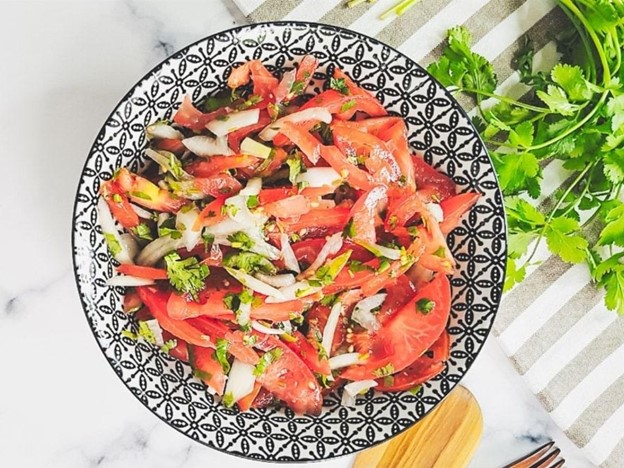When it comes to East African cuisine, the vibrant flavors and fresh ingredients take center stage. One dish that embodies the region’s love for freshness and zing is Kachumbari, a delightful tomato and onion salad. This colorful and aromatic side dish is a staple in East African homes and restaurants, adding a burst of flavor to any meal. Join us as we explore the culinary delights of East African Kachumbari and discover its fresh and zesty appeal.
Origins and Significance: Kachumbari has its roots in the Swahili-speaking regions of East Africa, including Kenya, Tanzania, and Uganda. The name “kachumbari” is derived from the Indian term “kichumber,” which refers to a similar salad popular in Indian cuisine. Over time, East Africans adapted the concept, incorporating their own unique blend of ingredients and flavors. Today, Kachumbari is not only a beloved accompaniment to meals but also a symbol of East African culinary heritage.
The Flavor Profile: What sets Kachumbari apart is its vibrant combination of fresh vegetables, herbs, and tangy citrus flavors. The primary ingredients are tomatoes and onions, which form the base of the salad. These are typically diced or sliced into thin strips, depending on personal preference. The tomatoes lend their juicy sweetness, while the onions provide a mild bite and crunch.
To enhance the flavors, Kachumbari often incorporates additional ingredients such as bell peppers, cucumbers, and chili peppers. These additions contribute to the salad’s refreshing and zesty character. A generous squeeze of citrus juice, usually from lemons or limes, adds tanginess and helps tie all the flavors together.
Aromatic herbs like cilantro (coriander leaves) and mint are frequently included, adding a burst of freshness and fragrance. Their bright green colors and distinctive aromas elevate the visual appeal and taste of the salad.
Preparation and Serving: Kachumbari is incredibly easy to prepare, making it a popular choice for everyday meals and festive occasions alike. The ingredients are simply combined in a bowl and tossed gently to ensure even distribution of flavors. It is recommended to let the salad sit for a few minutes before serving to allow the ingredients to mingle and the flavors to intensify.
This versatile salad complements a wide range of dishes. It is commonly served alongside grilled meats, roasted vegetables, pilau (spiced rice), or chapati (flatbread). The refreshing nature of Kachumbari makes it particularly well-suited for spicier dishes, as it provides a cooling contrast to the heat.
Health Benefits and Cultural Significance: Apart from its delicious taste, Kachumbari offers several health benefits. It is low in calories, rich in vitamins, antioxidants, and fiber, making it a nutritious addition to any meal. The fresh vegetables and herbs contribute to overall well-being and support a healthy lifestyle.
Beyond its nutritional value, Kachumbari holds cultural significance. It is a representation of East African culinary heritage and is often shared during communal meals and gatherings. Its vibrant colors and flavors reflect the diversity and vibrancy of the region’s people and landscapes.
East African Kachumbari is a celebration of simplicity and freshness. With its combination of juicy tomatoes, crunchy onions, zesty citrus, and aromatic herbs, this salad embodies the vibrant flavors of East Africa. Whether as a side dish or a standalone salad, Kachumbari is sure to invigorate your taste buds and add a burst of flavor to your meals. So, embrace the East African culinary tradition and indulge in the delightful world of Kachumbari—a fresh and zesty tomato and onion salad that will leave you craving more.








